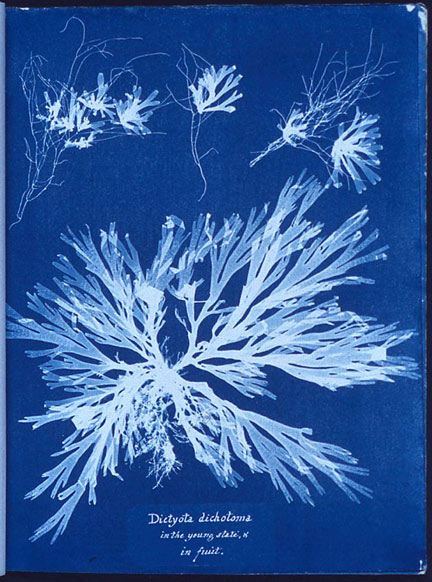
Anna Atkins
Dictyota dichotoma
cyanotype
from Photographs of British Algae, 1843-1853
Like many women in science of previous centuries, Anna Atkins (1799-1871) had the immense advantage of an educated father. John George Children was a prominent scientist and member of the Royal Society, and Atkins grew up in a house with a fully equipped laboratory. Children, a gentleman polymath, gave his name to a snake (Children’s Python) and a mineral (childrenite), but more importantly to Atkins, he was friends with two pioneers of photography – Sir John Herschel and William Henry Fox Talbot.
It was Herschel who pioneered the use of iron salts in photographic chemistry, inventing the now-familiar blueprint (or cyanotype). Shortly after Herschel’s invention of the blueprint method in 1842, Atkins used the method to document specimens of algae in a limited edition book, Photographs of British Algae. This book is both the first extant photographic work by a woman, and the first book produced entirely by photographic means.
To capture these images, Atkins did not use a camera: she employed what Talbot called the “photogenic drawing technique,” laying specimens directly on a plate of glass over a sheet of photoreactive paper, then exposing them to light. (Later, this type of print would become known as a “photogram.”) This method enabled Atkins to make large numbers of identical prints. She even used it to reproduce the introduction and title page of the book from handwritten calligraphy, instead of setting type in the conventional manner.
The New York Public Library has the entire book available online in digital form. The images are ghostly and delicate, relics of another era. As a watercolorist, I find them especially interesting: the deep iron blue pigment created by the blueprint process is Prussian Blue (PB27), my favorite watercolor blue – both for its patinated, weathered tone, and its moody depth, which has always reminded me of the sea.
The photogram method is still popular among contemporary photographers and artists; for a sampling, see the “rayographs” of Man Ray, the water images of Susan Derges, the empty bottle series of Susannah Hayes, body images by Tomy Ceballos, or go directly to this comprehensive list of photogram artists.
More on Anna Atkins:
The Pencil of Nature, Part II: Anna Atkins by Peter Marshall, About.com

The Himanthalia lorea. image is particularly lovely. Thanks for the information and the links, as it reminds me of a project I’ve been wanting to play with for some time….but haven’t gotten around to.